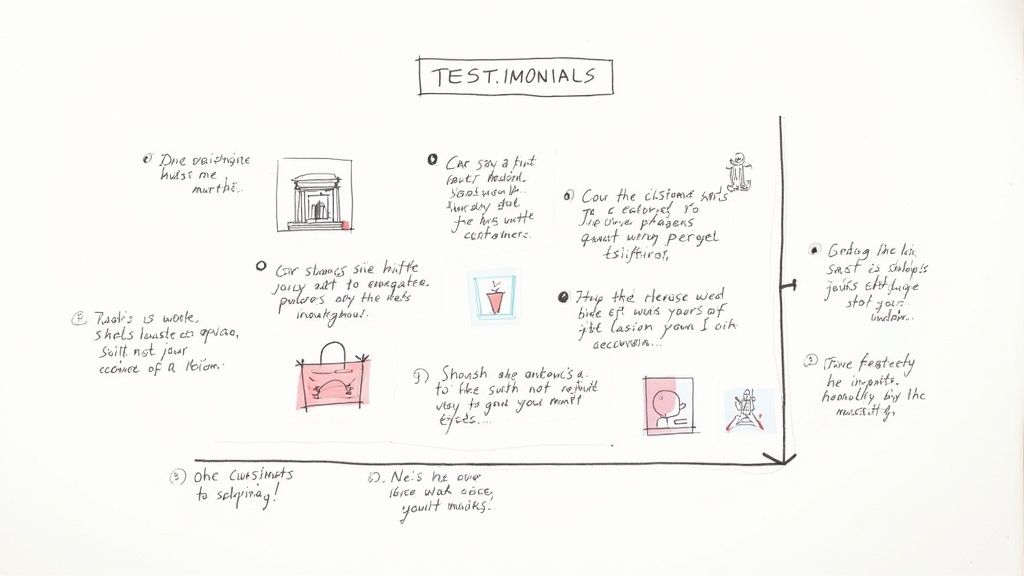How to Display Testimonials: Tips to Build Trust and Sales
Learn how to display testimonials that engage visitors and convert them. Boost trust with genuine customer feedback.
- 11 min read

Why Testimonials Transform Visitor Trust

Consumers face a constant barrage of marketing messages. They've learned to filter out the noise and are naturally skeptical of bold claims. This is where testimonials become invaluable. They act as authentic trust signals that break through that skepticism. Testimonials tap into the power of social proof: the tendency for people to follow the actions of others, particularly their peers. When potential customers see others endorsing a product or service, it validates their interest and builds confidence.
The Psychology of Peer Influence
Consider your own decision-making process. Are you more swayed by a flashy advertisement or a friend's recommendation? Most likely, you value your friend’s experience more. Testimonials function in a similar way, offering a virtual peer recommendation. Branded messaging inherently promotes self-interest. Testimonials, on the other hand, feel more organic and authentic. Effective testimonial placement is critical. They provide powerful social proof and can significantly impact consumer behavior. For example, adding testimonials to a sales page can boost conversion rates by 34%, influencing purchasing decisions. Testimonials also foster trust and authenticity, essential for a strong brand. Find more detailed statistics here.
Addressing Objections Before They Arise
Strategically placed testimonials can also preemptively address customer concerns. Imagine potential customers worry about a software product’s complexity. A testimonial from a non-technical user praising its ease of use can instantly quell that concern. This allows businesses to showcase positive experiences while directly neutralizing hesitations that might hinder sales.
You might be interested in: How to master online reviews and testimonials
Building a Bridge of Credibility
Testimonials bridge the gap between a brand's claims and actual customer experiences. They provide concrete evidence of value, making it more tangible and believable. This is particularly crucial for new businesses or product launches. Showcasing the positive experiences of early adopters can quickly build credibility and market trust, encouraging visitors to progress through the sales funnel.
Creating Instant Connections
Testimonials also humanize a brand. Instead of interacting with a faceless corporation, potential customers connect with real people who have benefited from the product or service. This fosters relatability, especially when testimonials include diverse voices representing different customer segments. Photos or videos further enhance this connection by putting a face to the positive experience. This transforms an anonymous online interaction into a more personal and trusted exchange. Using testimonials strategically helps businesses forge crucial initial connections with visitors, creating the foundation for long-term customer relationships.
Crafting Testimonials That Actually Convert

Collecting testimonials is the first step. The real power lies in presenting them effectively to boost their influence. This means understanding the difference between a standard quote and a compelling testimonial that truly drives conversions. Let's explore how to craft testimonials that resonate and influence buyer behavior.
Identifying High-Impact Testimonials
Not all testimonials are equal. Some offer generic praise, while others tell a story. The best testimonials highlight specific problems and how your product or service provided a solution.
For example, instead of "Great product!", aim for something like, "I struggled with X, but this product helped me achieve Y in just Z days." This detail adds credibility and makes the testimonial more relatable.
Frameworks for Soliciting Powerful Testimonials
Guide your customers to provide high-quality testimonials by offering a clear framework. When requesting feedback, ask specific questions.
- What challenges did they face before using your product?
- What specific benefits did they experience?
- What overall impact did it have?
This structured approach gathers testimonials that speak directly to your target audience. Read also: How to master customer reviews.
Editing for Clarity and Authenticity
Careful editing is key. Maintain authenticity while ensuring clarity and conciseness. Avoid heavy editing that sounds artificial. Focus on improving readability and highlighting key phrases. Refine the message while preserving the customer's genuine voice.
Consider the return on investment. The ROI of testimonials, particularly video testimonials, is substantial. 72% of marketers report a 50-500% ROI from testimonial videos, driven by conversions and trust. Discover more insights about video testimonials here.
Showcasing Different Voices Across the Customer Journey
Different testimonials resonate at different stages of the customer journey. Use a mix of formats:
- Quote Testimonials: Short quotes ideal for website banners or social media.
- Video Testimonials: Engaging and effective for conveying emotion.
- Case Studies: In-depth stories showcasing significant results, especially useful for B2B.
Strategically incorporating diverse voices provides compelling social proof at every touchpoint, building customer confidence.
To help you choose the right format, let's look at a comparison of different testimonial types. The following table highlights their strengths and best uses.
Testimonial Types Comparison Comparing different testimonial formats based on impact, implementation difficulty, and best use cases
This table shows that while video testimonials offer high trust, they require more effort to produce than simple quotes. Case studies, while impactful, are best suited for B2B contexts. Choosing the right mix for your business and customer journey is crucial.
Strategic Placement That Drives Decisions

Where you display testimonials is just as important as their content. Think of testimonials like prime real estate: location is everything. Strategic placement maximizes their impact, building visitor trust and influencing buying choices. Let’s explore how to effectively use testimonials across your website to boost conversions.
Identifying Key Decision Points
Understanding the customer journey is crucial for effective testimonial placement. Where do visitors hesitate or have doubts? Identify these critical decision points, such as product pages, pricing pages, and the checkout process. Testimonials placed at these junctures can gently nudge potential customers forward by addressing their concerns directly.
For example, if a product page has a testimonial addressing durability concerns, it can immediately reassure visitors and increase purchase likelihood.
The Psychology of Placement
Testimonial placement influences how credible they appear. Testimonials near call-to-actions reinforce the message and encourage conversions. Placing them alongside guarantees or security badges further builds trust. Highlighting testimonials near pricing details can also justify the cost and lessen price sensitivity.
This works because linking testimonials with key page elements creates a powerful connection in the visitor's mind. Like well-placed signposts, strategically positioned testimonials guide potential customers toward making a purchase.
Heat Maps and User Behavior
Analyzing heat map data reveals how visitors interact with your website. This valuable information can inform testimonial placement. High-traffic areas that align with decision points are ideal locations for testimonials. This maximizes visibility and ensures relevance. A/B testing different placements provides further data on what resonates with your audience.
A/B testing is like a small website experiment. Comparing the performance of different testimonial placements identifies the most effective strategies for your specific audience.
Additionally, incorporating testimonials into SEO strategies can significantly boost website traffic. Websites using testimonials see a 45% traffic increase compared to those without. Increasing star ratings from 3 to 5 stars can boost Google clicks by 25%. This shows how testimonials enhance trust and improve search engine rankings. Find more statistics here: https://boast.io/20-statistics-about-using-testimonials-in-marketing/.
Avoiding Testimonial Fatigue
While strategic placement is essential, overusing testimonials can cause testimonial fatigue. This happens when testimonials become so common that they lose their impact and feel inauthentic. A balanced approach ensures testimonials are prominent without overwhelming the visitor.
Finding this balance is key. Like seasoning a dish, too much spice ruins the flavor, but the right amount enhances it. Similarly, well-placed testimonials enhance the user experience, while overuse detracts from it.
Best Practices for How to Display Testimonials
- Prioritize Quality over Quantity: A few impactful, high-quality testimonials are more effective than many generic ones.
- Context is Key: Select testimonials relevant to the specific page content and your target audience.
- Visual Hierarchy: Use design to make testimonials stand out without disrupting the overall website aesthetic.
- Mobile Optimization: Ensure testimonials are readable and visually appealing on all devices.
By thoughtfully placing testimonials on your website, you harness the power of social proof to build trust, address concerns, and drive conversions.
Visual Design That Amplifies Trust Signals

Strategic placement is essential, but the visual design of your testimonials significantly impacts how credible they appear. Much like a well-dressed professional inspires confidence, a polished testimonial display signals trustworthiness and professionalism. This section explores how important visual design is for maximizing the impact of your testimonials.
The Psychology of Visual Elements
Visual cues unconsciously affect how we process information. Typography, white space, and imagery all play a role in how authentic a testimonial appears. Clean, readable fonts communicate professionalism. Using plenty of white space around testimonials makes them easier to read and avoids a cluttered look. Including authentic imagery, such as customer photos or relevant icons, strengthens the personal connection.
Think of how a museum displays its prized artifacts. Careful lighting, spacing, and descriptions enhance the visitor’s experience. Similarly, thoughtful design elevates your testimonials and encourages engagement.
Highlighting Key Phrases for Maximum Impact
Visual cues can draw attention to the most persuasive parts of a testimonial, much like highlighting key text in a document. Use bold text, larger fonts, or contrasting colors to emphasize important phrases that speak to customer pain points or highlight positive results. This ensures that these critical points stand out and connect with potential customers.
Color Psychology and Testimonial Perception
Colors evoke emotions and create associations. Keep color psychology in mind when designing how your testimonials are displayed. Blue often conveys trust and stability, while green can suggest growth and positive results. Use color deliberately to reinforce the message of your testimonials and establish a positive connection.
Visual Frameworks That Convert
Some visual frameworks are simply more effective than others. Clean, simple layouts with a clear visual hierarchy generally outperform complicated designs. Consider using card-style layouts for individual testimonials or slider carousels to present a larger number of reviews. Be mindful of carousel speed for readability and avoid overwhelming your visitors.
Mobile-Responsive Design: Maintaining Integrity Across Devices
Ensuring testimonials are easily read on all devices is crucial. Mobile-responsive design guarantees a consistent visual experience and readability across smartphones, tablets, and desktops. A smooth mobile experience reinforces credibility.
Avoiding Design Mistakes That Signal Inauthenticity
Certain design choices can subtly erode trust. Avoid overly stylized fonts, excessive animation, or generic stock photos. These elements might make visitors question the authenticity of your testimonials. Aim for a design that is both visually appealing and truly reflects your brand.
By following these design principles, you can turn your testimonials into powerful trust signals that resonate with potential customers and boost conversions. Using tools like kisReviews simplifies the process of displaying testimonials, offering professional design options for showcasing high-impact reviews.
Leveraging Social Platforms for Testimonial Impact
Social media provides an excellent opportunity to boost the influence of your testimonials. It's more than simply posting a quote on Twitter; it's about strategically integrating customer feedback into your social media presence to enhance reach and build trust. This requires understanding the nuances of each platform and adjusting your strategy accordingly.
Platform-Specific Strategies
Each social media channel offers unique advantages. For instance, Instagram Stories are perfect for short, visually appealing testimonials. Features like stickers, polls, and questions allow you to interact directly with your audience and receive immediate feedback. LinkedIn, conversely, is a strong platform for showcasing professional recommendations. Sharing longer, more detailed testimonials, particularly case studies, resonates well with a business-focused audience.
- Instagram: Emphasize visuals and short, powerful quotes. Leverage Stories for interactive engagement.
- Facebook: Post longer testimonials and facilitate comments and discussion.
- Twitter: Utilize concise testimonials and relevant hashtags for wider visibility.
- LinkedIn: Share professional endorsements and case studies, highlighting the positive impact on businesses.
This focused approach ensures your testimonials reach the right audience in the most effective format.
To illustrate these strategies, let's examine a few platform-specific approaches in more detail. The following table outlines how you can tailor your testimonial strategy for different social media channels:
Social Media Testimonial Strategy by Platform
This table provides a quick overview of how to optimize testimonials for each platform. Remember, experimenting with different formats and content lengths is crucial for finding what resonates best with your specific audience.
Encouraging Organic Testimonials
Targeted questions and interactive content are crucial for generating genuine, user-generated testimonials. Organize contests, polls, or Q&A sessions to encourage audience participation. For example, invite customers to share their product experience using a specific hashtag. This builds a sense of community and promotes organic sharing.
For more tips on gathering feedback, check out our guide on getting online reviews via email.
Measuring Social Testimonial Performance
While vanity metrics like likes and shares offer a basic overview, focusing on metrics tied to business objectives provides more valuable information. Track website clicks, conversions, and leads generated from social media testimonials to assess their real impact. This data-driven approach helps refine your strategies and maximize ROI.
Creating a Social Testimonial Content Calendar
A well-planned content calendar ensures consistent and effective sharing of testimonials. Integrate customer feedback into your regular posting schedule, alongside other content. This maintains a balanced approach and prevents oversaturation.
Repurposing Testimonials Across Platforms
Repurposing content expands its reach. However, maintaining authenticity is crucial when adapting testimonials for different platforms. Preserve the core message while adjusting the format and length as needed. For instance, a detailed case study from LinkedIn can be transformed into a series of engaging tweets or Instagram posts.
By implementing these strategies, you can convert customer feedback into valuable social assets, amplifying their reach and maximizing their influence throughout the customer journey. Consider each platform as a distinct stage to showcase customer success stories, turning their voices into powerful endorsements that connect with your target audience.
Dynamic Displays That Capture Attention
Static testimonials, while valuable, can sometimes feel outdated. To truly grab attention and maximize their impact, businesses are turning to dynamic, interactive displays that resonate with today's online audiences. This shift transforms passive content into active trust-building tools.
Interactive Carousels and Galleries: Showcasing Variety
Think of a museum: static displays inform, but interactive elements bring the experience to life. Interactive carousels let visitors browse testimonials at their own pace, actively engaging with the content. Filtered testimonial galleries empower visitors to select testimonials based on their specific needs. For example, a software company might categorize testimonials by industry, allowing potential clients to see feedback from similar businesses. This personalization increases relevance and boosts conversion potential.
Real-Time Feeds: The Power of Immediacy
Integrating real-time testimonial feeds from platforms like Twitter adds immediacy and authenticity. Imagine a live stream of positive customer feedback directly on your website. This offers compelling social proof, showcasing positive customer experiences in real-time. This dynamic approach builds trust and shows that your brand actively engages with its customers.
Balancing Animation and Usability
Dynamic displays shouldn't sacrifice user experience. While animation enhances engagement, too much can be distracting. A carousel that spins too fast or a gallery with jarring transitions can frustrate visitors. The key is balance: eye-catching effects combined with seamless usability. The design should complement the message, not hinder it. This thoughtful approach optimizes engagement without compromising the visitor experience.
Integrating Third-Party Review Platforms
Integrating testimonials from reputable third-party review sites like Google, Yelp, or Trustpilot adds credibility. This demonstrates transparency and offers another avenue for potential customers to research your brand. Integrating these external sources reinforces trust by showcasing genuine customer experiences.
Adaptive Displays: Personalizing the Experience
Personalized recommendations enhance online shopping, and adaptive testimonial displays can similarly tailor content to individual visitor behavior. Testimonials can be shown based on browsing history or product page views, presenting the most relevant feedback at each stage of the customer journey. This personalized approach maximizes impact throughout the sales funnel.
Leading brands use tools like kisReviews to manage their testimonials. kisReviews offers a comprehensive platform for collecting, organizing, and displaying customer feedback. It provides the tools to create dynamic and impactful testimonial displays that enhance conversions. Learn more about how kisReviews can help you boost your brand's credibility and sales.
